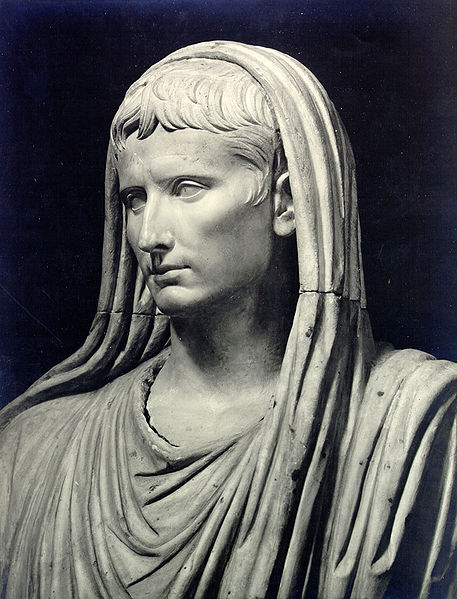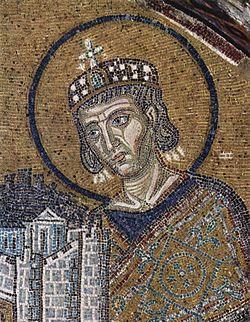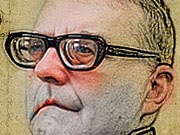 |
| Trinity Carving from St Denis, Paris |
Two issues arising during the establishment of the
Christian Church would shake belief and progressively work to undermine unity. The first, which has been covered to some extent earlier on, was the heated debate and subsequent establishment of canon law regarding
the divinity of Christ, which resulted in heretical condemnation during and after the Council of Nicaea. The second was the
implied position of the Emperor within the church once Christianity was embraced by the state.
Divinity of Christ
The
Council of Nicaea established Christ as being eternally one in the same God as the Father and Holy Spirit, a rather complicated form of monotheism that wasn’t altogether easy to accept in some quarters and was to an extent met with hostility. However, the bishops that gathered for the Council of Nicaea were determined to nail down trinitarian details as well as instituting the specific nature of Christ’s own divinity, even though
Christ and the Evangelists had been satisfied with leaving these concepts as open (even ambiguous) articles of faith. Following the establishment of the Nicene Creed, the matter would be considered closed. Continued debate regarding Christ’s divinity was deemed heretical.
Afterwards, the
Nicene Fathers would be considered corrupt by the
dissenting bishops who subsequently suffered loss of position and eminence within the church. Moreover, many
followers of the vilified bishops would remain sympathetic to the plight of their bishops, while remaining constant in their own beliefs. Thereafter,
Arianism and
Gnosticism, the larger sects, would only
manage to survive along and beyond the
frontiers of the empire, away from the watchful eyes of the established centers of theology.
The
rogue Christian sects would continue flourishing to some extent, due to the tenacious resolve of a
handful of zealot sectarian
missionaries. However, as the central church grew, the expelled beliefs would eventually fad into legend and a different threat of divided leadership would overtake, grow and eventually split the Church into two separate spheres of ecclesiastical influence.
Pontifex Maximus
 |
| Augustus as Pontifex Maximus |
Acting Head of State Religion
The evolving second point of consternation, and the main topic of this article, would be
the implied decision making capacity of the emperor regarding articles of faith. When
Emperor Constantine convened the
Council of Nicaea (325 CE) he did so as
Pontifex Maximus, deliberately placing himself into a chair position over
ecclesiastical proceedings, a position that, for all appearances, was above that of
the pope.
Extraordinary as such a relationship may seem today, it certainly would not have been viewed negatively in Constantine’s time. This is especially true when one reviews the executive role of previous emperors within
the Roman Empire’s pagan state religion. Beginning with
Emperor Augustus (27 BCE - 14 CE), the position of
Pontifex Maximus was subsumed into the Imperial office. This enabled the
Roman Senate to establish religious decrees. It exercised this control in 14 CE when it proclaimed
Emperor Augustus a god after his death. When
Constantine initially became involved during Christian unrest, he was simply exercising his role as Pontifex Maximus.
Putting this event into historic context,
Pope Sylvester was likely ecstatic over Constantine’s decision to not only
consult with him in advance of the first Christian council, but to also request papal attendance at Nicaea (later unable to attend,
Sylvester sent two legates to rule in his absence). After all, the imperial involvement suggested by Constantine’s request would have been viewed as an essential first step to replacing paganism with Christianity as the state religion. Sylvester had to regard this as a positive, even a momentous occasion for his relatively new church, an opportunity he couldn’t possibly dismiss. However,
sending legates in his stead would prove a bad precedent.
Benefits and Consequences
Long-term consequences of imperial involvement in church matters would be considerable. Ultimately, it would be the emperor's involvement in Church affairs that would lead to the great
East-West Schism of 1054. Even if the emperor’s role was only secular (which it clearly was not), it implied a leadership role. However, even that price mustn’t have seemed too unreasonable during
Constantine’s reign. Persecution of the faith had just ended and the
Edit of Milan legalized the practice of Christianity. Emperor Constantine may have simply wanted to add some weigh to a secterian argument.
Besides, a partnering Emperor might be expected to
destroy pagan temples,
enforce canon, and
contribute much needed funding. Once established, he could then act as
"Protector of the Faith", while
supporting the construction of churches and
monasteries (this would certainly prove to be the case). By comparison, the
Pope’s role was purely
ecclesiastical and he likely
(naively?) had no illusions of anything grander.
Solidifying the Emperor’s Quasi-Clerical Role
The emperor’s position within the church would be further affirmed half a century later in 380 CE, when
Emperor Theodosius I, a big supporter of
Nicene Trinitarianism, declared
Christianity the state religion, ending support for polytheistic
Hellenistic beliefs which dated back to the founding of Rome. Any implied leadership role that Emperor Constantine may have only hinted at, now became a formal declaration under Emperor Theodosius.
Consequently, having firmly placed himself at the head of the
state religion, the Emperor would have the power to convene
church councils whenever division appeared to be present amongst his Christian subjects. Constantine had done this at Nicaea because of
visible religious unrest. However, the continued development of
canon law and its intricacies cannot be
compared to the theological simplicities of the far more tolerant pagan belief of earlier times. Moreover, no matter how theologically astute an emperor may be, he would, as the
secular head, be obligated to consider and be influenced by
temporal matters when presiding over
canonical debate.
As logical as
secular considerations may have seemed, they would ultimately
frustrate the purely ecclesiastical minds of church leaders, especially when goals were sometimes driven by faith or even internal church politics.
The emperor would be subject to take the side of church members he was closest too and most influenced by. Invertible, that would be the
Eastern bishops. In short, having the emperor decide ecclesiastical matters would continually
put him at odds with the western Pope.
This point of tension would begin to come to a head late in the eighth century when
Emperor Leo V would impose personal convictions as church canon regarding opposition to religious images, known as
Byzantine Iconoclasm. This would prove to be a serious breaking point between the
Constantinople and
Rome. Consequently, the
emperor would question the Pope's role and vice versa. The difference being, by then, the Roman Church had become self-sufficient.
Byzantine Iconoclasm
First Iconoclastic Period
The
first Iconoclasm period lasted between the years 726 and 787 CE. In 726, Byzantium had experienced volcanic eruptions in the Aegean Sea and subsequent tsunamis around the same time their military had suffered setbacks against Islamic forces.
Emperor Leo III interpreted these events as punishment from God regarding the empire’s use of religious imagery.
Exactly how Emperor Leo came to this particular conclusion remains unclear. However, it is likely he was already familiar with
Muslim Iconoclasm that began more than ten years earlier. Therefore, he may have surmised the downturn in the Empire’s fortunes to be likely proof the Muslims were on to something with their own Iconoclasm. However, both Leo and the Muslims may have been influenced by the much earlier
Synod of Elivira (now Granada, Spain) in 305-6 CE, attended by nineteen bishops, and twenty-six
presbyters. During this earlier Synod, the veneration of religious icons had been ruled as heretical.
The Emperor issued his edict of 730 CE forbidding the veneration of sacred images. He did this without first consulting the church. Not surprisingly, he obtained mixed support throughout Byzantium, while encountering strong opposition from both
Pope Gregory III.
Germanos I, Patriarch of Constantinople, resigned in protest. Consequently, Pope Gregory held two
holy synods condeming Leo’s actions.
Leo dies in 741 and his successor,
Constantine V (741-775), proved to be more passionate in the anti-image stance. In 754, Constantine called the
Council of Hieria. Under the Emperor’s direction the sacred images were banned as being
“...vain and introduced by the devil”. The council then claimed itself to be the legitimate “Seventh Ecumenical Council”. This claim was later disregarded, as none of the five patriarchs or the
Pope agreed or attended. Constantine’s son,
Leo IV (775-80) seemed content to avoid the issue and when, after his death, his wife
Irene became Regent, she requested the Pope convene the Second Council of Nicaea in 786, where image veneration was restored.
Second Iconoclastic Period
After the empire had
suffered additional military setbacks at the hands of the Bulgarian Khan Krum, Emperor Leo V once again took up the mantel of Iconoclasm. If the earlier
Leo III had ignored the church with his edict of 730, Leo the V would exert his Pontifex Maximus position and overrule the dictates of
Seventh Ecumenical Council of 787 CE. The Emperor formed a
council of his own at the Hagia Sophia and rendered the
Synod of 815 to reinstate the iconoclasm ruling. This ruling would further widen the now growing differences between Constantinople and Rome.
Iconoclasm would finally end in 843. Since that time it has been celebrated in the Orthodox Church as the feast of the
“Triumph of Orthodoxy”. However, unity between the West and East would never recover from the Imperial councils, edits and synods, none of which were attended or sanctioned by the western papacy.
Western Independence
Broken Communications and Isolation
With the
absences of an imperial army and regular courier services, correspondence between the two spheres declined along with the timely transmission of theological matters from the East, at a time when church canon was being developed. Late or nonexistent communications would contribute to growing friction. This would result in the papacy being informed of ecclesiastical rulings, often decided by the Emperor, weeks or months after the fact.
The growing isolation and subsequent independence of the
Western Latin Church, which began after the western
Emperor Romulus Augustulus was deposed in 476 CE, would contribute to the growing divide between Rome and the
Emperor dominated Eastern Church.
Conquering Goths that followed Romulus Augustulus would permit the papacy and western clergy to practice freely. These new rulers expressed no concerns with the workings of the church. Subsequently, the Western Church relished its new-found freedom. The resulting involvement with the
Eastern Church would be
limited to church councils and, increasingly infrequent, communications on theological matters.
Language Drift
The
Latin west began to migrate away from the Greek bible of the East as early as 382 CE, when
Saint Jerome began his translations to Latin text. By 405 CE, Jerome had completed the entire Latin bible,
“the Vulgate”. Those Latin transcriptions began to replace Greek copies throughout the West. By the
6th Century, the Roman Rite of Latin in the Mass had begun. Afterwards, Greek would not be spoken in the Western Church. Greek text would then be consigned to the ecclesiastical archives of Rome.
Latin also became the dominant written language throughout Christian Europe. It would remain the formal written text within government and universities throughout Europe
until the 15th and 16th centuries, and a required study in all universities until the end of the 19th Century.
The more the clergy of Western Europe drifted away from the
Greek Vulgate the more its
secular population embraced Latin. Moreover,
Latin influence would cause the English language to evolve from
Proto-Germanic. Eventually, the languages of
Italy,
Gaul and
Hispania would develop with appreciable amounts of Latin within their dialects. These are today referred to as the
“Romance Languages”.
Commentary
 |
Ecclesiastical Division - 1599 painting "Battle Between Carnival and Lent" by Pieter Bruegel
|
While the Church’s preoccupation over divided governance and theological concepts continued to grow beyond the
simple genre of the Gospel, the determined and focused forces of
Islam would continue to expand dominion and religious following, encompassing
a territory greater than the Roman Empire in less than a century. While Islam absorbed Christian territory in Africa, Asia Minor and the Far East,
Rome and Constantinople argued over continued veneration of painted images. Meanwhile, estranged
Arian and
Gnostic sects would leave their homes in Rome and Constantinople behind to spread specialized brands of Christianity along the Empire’s frontiers, often times inadvertently seeding a path for
Muslim monotheism.
Like
Saint Paul traveling to Rome from the East only to have his physical body separated from its head, the Papal head of the
Western Latin Church would continually drift from the East until it too would suffer a
permanent separation from its originating theological body.
As the next few centuries would unfold, the Eastern Greek Church would lose more than its papacy. Muslim conquests would continue to absorb Byzantine territory (see map) until
Constantinople and all the eastern centers of Christian theology would be conquered, forever ending Easter imperial rule. However, before that would happen,
Charlemagne would reinvent the West while the papacy
would learn not to repeat its mistake of imperial Pontifex Maximus.
Click here for 10) Charlemagne's Revitalized Europe
Got Feedback?
Comments? Questions? Corrections? Any feedback at all? Just click on the comments box at the bottom of this page and enter your thoughts. All comments are welcome.
You might also be interested in...
Copyright ©2013 Tom Mallon. All rights reserved.


















No comments:
Post a Comment